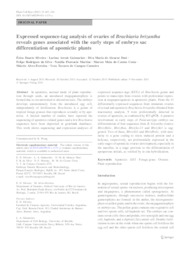Expressed sequence-tag analysis of ovaries of Brachiaria brizantha reveals genes associated with the early steps of embryo sac differentiation of apomictic plants.
Expressed sequence-tag analysis of ovaries of Brachiaria brizantha reveals genes associated with the early steps of embryo sac differentiation of apomictic plants.
Author(s): SILVEIRA, E. D.; GUIMARÃES, L. A.; DUSI, D. M. de A.; SILVA, F. R. da; MARTINS, N. F.; COSTA, M. M. do C.; ALVES-FERREIRA, M.; CARNEIRO, V. T. de C.
Summary: Abstract - In apomixis, asexual mode of plant reproduction through seeds, an unreduced megagametophyte is formed due to circumvented or altered meiosis. The embryo develops autonomously from the unreduced egg cell, independently of fertilization. Brachiaria is a genus of tropical forage grasses that reproduces sexually or by apomixis. A limited number of studies have reported the sequencing of apomixis-related genes and a few Brachiaria sequences have been deposited at genebank databases. This work shows sequencing and expression analyses of expressed sequence-tags (ESTs) of Brachiaria genus and points to transcripts from ovaries with preferential expression at megasporogenesis in apomictic plants. From the 11 differentially expressed sequences from immature ovaries of sexual and apomictic Brachiaria brizantha obtained from macroarray analysis, 9 were preferentially detected in ovaries of apomicts, as con?rmed by RT-qPCR. A putative involvement in early steps of Panicum-type embryo sac differentiation of four sequences from B. brizantha ovaries: BbrizHelic, BbrizRan, BbrizSec13 and BbrizSti1 is suggested. Two of these, BbrizSti1 and BbrizHelic, with similarity to a gene coding to stress induced protein and a helicase, respectively, are preferentially expressed in the early stages of apomictic ovaries development, especially in the nucellus, in a stage previous to the differentiation of aposporous initials, as veri?ed by in situ hybridization.
Publication year: 2012
Types of publication: Journal article
Observation
Some of Embrapa's publications are published as ePub files. To read them, use or download one of the following free software options to your computer or mobile device. Android: Google Play Books; IOS: iBooks; Windows and Linux: Calibre.
Access other publications
Access the Agricultural Research Database (BDPA) to consult Embrapa's full library collection and records.
Visit Embrapa Bookstore to purchase books and other publications sold by Embrapa.

